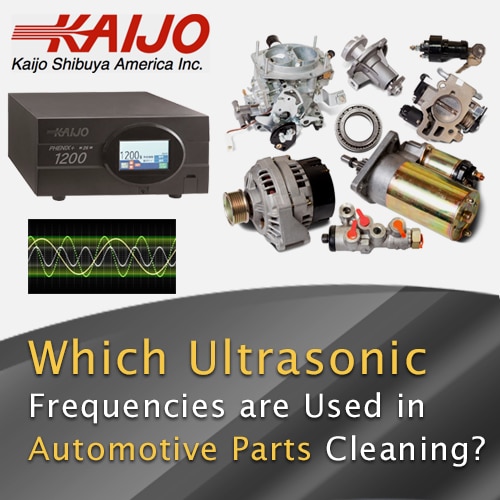Which Ultrasonic Frequencies Are Used in Automotive Parts Cleaning?
August 6, 2020
 Automotive parts generally have hard surfaces and are comparatively rugged. This allows ultrasonic cleaning to take place at the lower end of the ultrasonic frequency spectrum where the powerful cleaning action might damage more fragile components. Within that lower range, there is still room for optimizing cleaning performance by exactly matching the ultrasonic frequency to the automotive parts to be cleaned. Solid, rugged steel parts can be cleaned rapidly and completely at the lowest available frequencies while more delicate parts or parts with special coatings may benefit from a more gentle cleaning at slightly higher frequencies.
Automotive parts generally have hard surfaces and are comparatively rugged. This allows ultrasonic cleaning to take place at the lower end of the ultrasonic frequency spectrum where the powerful cleaning action might damage more fragile components. Within that lower range, there is still room for optimizing cleaning performance by exactly matching the ultrasonic frequency to the automotive parts to be cleaned. Solid, rugged steel parts can be cleaned rapidly and completely at the lowest available frequencies while more delicate parts or parts with special coatings may benefit from a more gentle cleaning at slightly higher frequencies.
Why Using the Right Ultrasonic Frequency is Important
Ultrasonic cleaners work by using ultrasonic generators to produce microscopic cavitation bubbles as the ultrasonic sound waves pass through the cleaning solution. The bubbles form in the low-pressure troughs of the sound waves and implode in the high-pressure peaks. When the bubbles implode, they produce a tiny, high-energy jet that strikes the surface of the part to be cleaned, dislodging dirt and removing contaminants.
The size of the bubbles and the energy of the jets depend on the ultrasonic frequency, with lower frequencies producing larger bubbles and more powerful jets. The ideal match between frequency and part to be cleaned uses a frequency whose jets are powerful enough to clean quickly but not powerful enough to damage part surfaces, coatings, plating or small structures. An experienced and competent automotive ultrasonic cleaning system supplier can help customers choose the optimal frequency suitable for cleaning a particular part with specific contaminants.
Kaijo Helps Customers Choose the Right Frequency for Automotive Cleaning
Typical parts that can be cleaned with automotive ultrasonic cleaners include brake parts, injector nozzles, carburetor parts, differential components and cylinder heads. In each case Kaijo looks at the part material and surfaces, the amount of contaminating material and the contaminants’ composition. For the most common automotive parts to be cleaned with ultrasonic systems, Kaijo would recommend the following:
• Brake cylinders have delicate machined surfaces that could be damaged by mechanical scrubbing but the surfaces are robust enough for cleaning with low-frequency ultrasound. Kaijo recommends using the company’s Phenix+ ultrasonic cleaner with a frequency of 26 kHz.
• Fuel injector nozzles can be soaked to remove some deposits but they still need manual cleaning that can damage the finely calibrated openings. Ultrasonic cleaning avoids such damage and Kaijo recommends using the Phenix+ ultrasonic cleaner with a frequency of 38 kHz.
• Cylinder heads need to be cleaned before re-assembly. The carbon deposits and fuel varnish are easily removed at lower ultrasonic frequencies that can be used on these rugged parts. Kaijo recommends the Phenix+ system at 26 kHz.
• Carburetor components are delicate and easily damaged with comparatively light contamination. They are hard to clean completely because of the small openings and orifices as well as the complex shapes of the parts. Kaijo recommends using the Phenix Hyper ultrasonic cleaner at 78 kHz.
• Differential casings and gears have to have gear oil removed before re-assembly. With ultrasonic cleaning, gear oil can be cleaned without using dangerous solvents. Because the casings and gears are robust components with hard surfaces, Kaijo recommends using the Phenix+ ultrasonic cleaner with a frequency of 26 kHz.
Automotive ultrasonic cleaners such as the Kaijo Phenix line can be used to effectively and quickly clean other automotive parts as well. Benefits include reduced manual cleaning time, reduction of chemical use and less danger of mechanical damage to part surfaces.
Kaijo Can Help Reduce Costs and Improve Automotive Parts Cleaning
With Kaijo’s extensive experience in the ultrasonic cleaning industry and extensive line of ultrasonic cleaning equipment, the company has helped customers achieve effective automotive part cleaning results. By using the right ultrasonic system from Kaijo cleaning performance is improved and costs are reduced because less time is spent on manual cleaning, and fewer cleaning supplies are required.





